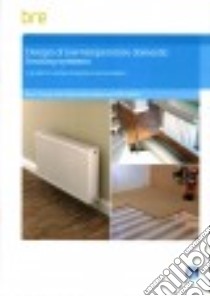Design of Low-temperature Domestic Heating Systems - 9781848063433
Un libro in lingua di Bruce Young Alan Shiret John Hayton Will Griffiths edito da Taylor & Francis, 2014
- € 26.40
- Il prezzo è variabile in funzione del cambio della valuta d’origine
Low-temperature systems can improve energy efficiency and hence reduce fuel consumption and CO2 emissions. There is growing interest in low-temperature hydronic central heating systems, ie those where water is used as the medium to distribute heat around the building, and in which the water leaving the heat generator is limited to a lower temperature than in normal system design. This BRE Trust Report is aimed as a guide for those who wish to install low-temperature heating systems in dwellings, and concentrates on the calculations and other conditions necessary to ensure that low-temperature operation can be achieved.
It became apparent during the preparation of this guide that there is no generally well-established and understood design method for low-temperature domestic heating systems. Instead of simply gathering information on current practice, the authors found it necessary to engage in extensive debate about many of the technical parameters governing system sizing, configuration and selection of components. Some of these have not been fully resolved. In particular, leading designers should give more attention to:
-selection of a representative external temperature for heat loss calculations
-allowance for building exposure
-suitable heat loss calculators, conforming to stated rules
-refined intermittency factors, perhaps using the advanced method set out in BS EN 12831:2003
-evaluation of emitter responsiveness, especially for emitters with fans
-temperature-limiting controls, and modulation by reference to an upper temperature limit.
The last item (controls) is especially important, as it is the water temperature at the heat generator that is the principal determinant of efficiency when low-temperature system designs are contemplated. Further development of standard design and operating practices (especially for controls) for low-temperature systems will be necessary before low-temperature systems can be recognised as a mature option capable of providing energy savings in all cases.
Informazioni bibliografiche
- Titolo del Libro in lingua: Design of Low-temperature Domestic Heating Systems
- Sottotitolo: A guide for system designers and installers
- Lingua: English
- Autori : Bruce Young Alan Shiret John Hayton Will Griffiths
- Editore: Taylor & Francis
- Collana: Taylor & Francis (Paperback)
- Data di Pubblicazione: 14 Febbraio '14
- Genere: TECHNOLOGY and ENGINEERING
- Pagine: 23
- Dimensioni mm: 292 x 203 x 6
- EAN-13: 9781848063433


